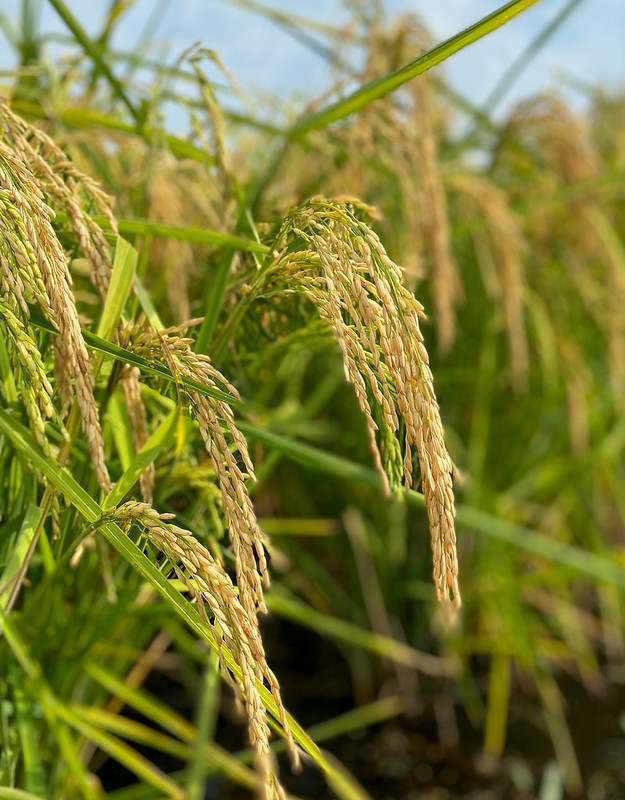Rice planting rockets ahead for northeastern Arkansas
April 21, 2023
By Ryan McGeeney
U of A System Division of Agriculture
Fast Facts:
- USDA: At least a third of planned Arkansas rice acreage already planted
- Moderate rains in northeast aide planting
- Rice growers likely to expand acreage where available
(572 words)
(Newsrooms: With file art of rice plant.)
LITTLE ROCK — Into every life, a little rain must fall. But sometimes it’s nice if it doesn’t all come at once.
For the first season in several years, Arkansas rice growers, particularly in northeastern Arkansas, are far ahead of schedule. According to the U.S. Department of Agriculture, the state’s growers had planted 33 percent of their 1.2 million planned rice acres as of April 16 — about two-thirds better than the five-year average of 20 percent for this point in the season.
Jarrod Hardke, extension rice agronomist for the University of Arkansas System Division of Agriculture, said USDA’s estimate is likely conservative.
“Based on conversations with agents and growers and my own observations, I thought we were pretty close to 40 percent planted on Monday,” Hardke said. “By Wednesday, I realized I was probably underselling it. At this point, we could be bumping 60 percent planted rice acreage by the end of the week.”
Right place, right time
How is this happening? For just enough growers, it’s a case of right place, right time, Hardke said. Although much of the region has experienced substantial rainfall — and even tornadoes — throughout the spring, the northeastern corner of the state has seen more moderate rains that have managed to keep soils moist without bringing work to a halt.
“Growers up there got a lot of land preparation done in the fall, so they were ahead of the game anyway,” Hardke said. “With the lighter rains, they’ve been able to keep hammering away. There are a lot of growers up there who are either done planting rice or are about to be.”
Of course, that has not been everyone’s experience. While rice growers in the central-east corridor made substantial progress early in the season, heavy rainfall and tornado-related destruction slowed and even reversed progress for those growers. Planting progress in the southeastern corner of the state has also slowed significantly in the last two weeks.
Hardke said that while this year’s rice planting is far ahead of the five-year average at this point, it’s still not in the top three years over the past decade.
“Now, if by next Monday, we’ve jumped another 25 percent, we’re going to be in the neighborhood of some of the absolute fastest planting we’ve ever had,” he said. “You might call this extraordinary progress.”
More rice acres?
A typical side-effect of a successful early-plant year is that growers will expand rice beyond their original planned acreage. Hardke said that growers seem to be acquiring additional seed where available.
“In any given year, our final acreage for long-grain rice will go back to what kind of April we have. And so far, it’s been a pretty good one,” he said. “Barring a major stoppage, I think we could hit 1.4 million acres of rice planted.”
While there are no inherent drawbacks to completing planting quickly, Hardke said aggressive planting earlier in the season can lead to management challenges when harvest approaches.
“Guys are planting anything and everything they can get in the ground right now,” he said. “They’ve been planting rice, beans and corn. Some guys are completely done with all three crops already. The issue is going to be managing all of those crops in a timely manner during the season, and then getting them all out at harvest when they begin to stack on top of each other.
“They’ll be some interesting dynamics as the season plays out,” he said.
To learn about extension programs in Arkansas, contact your local Cooperative Extension Service agent or visit www.uaex.uada.edu. Follow us on Twitter and Instagram at @AR_Extension. To learn more about Division of Agriculture research, visit the Arkansas Agricultural Experiment Station website: https://aaes.uada.edu/. Follow on Twitter at @ArkAgResearch. To learn more about the Division of Agriculture, visit https://uada.edu/. Follow us on Twitter at @AgInArk.
About the Division of Agriculture
The University of Arkansas System Division of Agriculture’s mission is to strengthen agriculture, communities, and families by connecting trusted research to the adoption of best practices. Through the Agricultural Experiment Station and the Cooperative Extension Service, the Division of Agriculture conducts research and extension work within the nation’s historic land grant education system.
The Division of Agriculture is one of 20 entities within the University of Arkansas System. It has offices in all 75 counties in Arkansas and faculty on five system campuses.
Pursuant to 7 CFR § 15.3, the University of Arkansas System Division of Agriculture offers all its Extension and Research programs and services (including employment) without regard to race, color, sex, national origin, religion, age, disability, marital or veteran status, genetic information, sexual preference, pregnancy or any other legally protected status, and is an equal opportunity institution.
# # #
Media Contact:
Ryan McGeeney
rmcgeeney@uada.edu
@Ryan_McG44
501-671-2120
